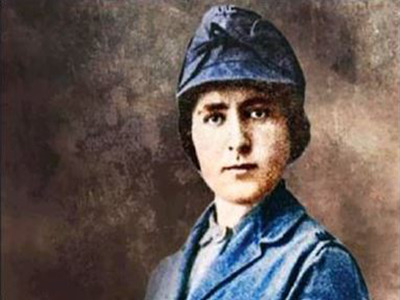A Tagore Fan, This Jewish Traveller Connected India, Israel & Lithuania!
A new book brings to life the fascinating encounter between the Lithuanian-born Jewish traveller and Tagore.

It’s not often that we discover such strong historical and cultural links between three countries—India, Israel and Lithuania—peppered with some of the fascinating minds of the 20th century.
Last month, the embassies of Israel and Lithuania launched a new book by Israeli scholar Dr Shimon Lev called “From Lithuania to Santiniketan” detailing the fascinating life and times of a Lithuanian-born Jewish traveller Schlomith Frieda Flaum.
The book is reportedly divided into three parts—an introduction by Dr Lev, excerpts from Flaum’s original works about Tagore and India, which were translated into English from Hebrew, and copies of the letters Flaum and Tagore exchanged from 1922 to 1940.
Flaum was born in Lithuania on March 18, 1893. So what drove a young Jewish woman and teacher to the shores of India in the early 1920s? It was a chance encounter with one of India’s greatest literary figures Rabindranath Tagore, who was delivering a lecture at a Jewish synagogue in New York. Flaum was then an unmarried trainee doing a course for teachers at Columbia University. Fascinated by Tagore, she set sail for India in 1922.
Also Read: How an Auschwitz Survivor Helped India Get Israel’s Aid in the 1971 War
Flaum spent two years at the Visva Bharati college founded just a few months before she arrived at Shantiniketan, the prestigious seat of learning founded by Tagore, teaching German to students while learning bits and pieces of Sanskrit and Bengali.
She left behind an account of Tagore, India and life in Europe for the Jewish community at a very difficult time in their history, offered with what many academics consider a femicentric view of the world at a time when such a worldview wasn’t widely accepted.
According to academics who have studied her works what remains truly insightful is her memorable account of Tagore and Shantiniketan during the early days of Viswa Bharati where “you feel the heartbeat of Bengal, the land of poetry and imagination.”

She details of a time “when India was brimming with the ideas of transformation, and the West was rediscovering Asia with India at its navel,” according to this Lithuanian Embassy tribute to Flaum.
During her stay at this popular seat of learning, she also met other leaders of the freedom movement, including Mahatma Gandhi, Annie Beasant and Sarojini Naidu. Even after leaving India in 1924, she met Tagore again six years late in Berlin. In 1946, she wrote Tagore’s biography in Hebrew.
Also Read: Remembering The Extraordinary Musafir From UP Who Connected India & Central Asia
So enamoured was Flaum with Tagore’s intellectual and creative genius that she “reached the state of mind Indians describe as a state of permanent ecstasy.” Besides her extensive travels around the world, she was also pioneering new methods of teaching as an educator.
Flaum died in the Jewish homeland of Israel on January 2, 1963, poor, lonely, miserable and forgotten. But thankfully, her works live on across the decades.
(Edited By Vinayak Hegde)
Like this story? Or have something to share? Write to us: [email protected], or connect with us on Facebook and Twitter.
NEW: Click here to get positive news on WhatsApp!
If you found our stories insightful, informative, or even just enjoyable, we invite you to consider making a voluntary payment to support the work we do at The Better India. Your contribution helps us continue producing quality content that educates, inspires, and drives positive change.
Choose one of the payment options below for your contribution-
By paying for the stories you value, you directly contribute to sustaining our efforts focused on making a difference in the world. Together, let’s ensure that impactful stories continue to be told and shared, enriching lives and communities alike.
Thank you for your support. Here are some frequently asked questions you might find helpful to know why you are contributing?


This story made me
-
97
-
121
-
89
-
167











